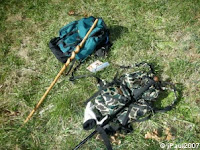 This week’s hike was about 5 miles (round trip) of the Gallaher Bend Greenway near the Oak Ridge National Laboratory property. The trail begins on the southern side of Clark Center Park (formerly Carbide Park) and runs through woods and fields near the Clinch River that eventually fills the Melton Hill Dam Reservoir.
This week’s hike was about 5 miles (round trip) of the Gallaher Bend Greenway near the Oak Ridge National Laboratory property. The trail begins on the southern side of Clark Center Park (formerly Carbide Park) and runs through woods and fields near the Clinch River that eventually fills the Melton Hill Dam Reservoir.My hiking partner (Ron) and I found this huge old
 hackberry tree in one of the fields in the area. An old ERDA (Energy Research and Development Administration – 1974) sign (formerly the AEC – Atomic Energy Commission – 1946) marks, explains, and protects this particular tree. The AEC/ERDA functions were transferred to the Department of Energy (DOE) in 1977. I write all this to give some sense of the age of the sign!
hackberry tree in one of the fields in the area. An old ERDA (Energy Research and Development Administration – 1974) sign (formerly the AEC – Atomic Energy Commission – 1946) marks, explains, and protects this particular tree. The AEC/ERDA functions were transferred to the Department of Energy (DOE) in 1977. I write all this to give some sense of the age of the sign!The common hackberry tree has been included in windbreak plantings by farmers to control wind erosion. Additionally, its deep root system makes common hackberry useful for preventing soil erosion on disturbed sites.

Native Americans valued common hackberry for medicinal, food, and ceremonial purposes. Medicinally, the bark was decocted to serve as a gynecological aid that could induce abortion, regulate menstrual cycles, and treat venereal diseases. Bark decoctions were also taken for sore throats.
Historically, southern church pews were made of hackberry wood.
Again, I am blessed to live in an area full of hiking trails that run straight through history.
















10 comments:
Dude, I learned a new word. Had to look up "decocted". Good job.
Sounded painful didn't it?
Once again, Obi Wan. Thought you had mistyped "concocted", or something. Googled it and sure enough. You'll have to use it over at the cooking site... First decoct the onion sauce in a medium size skillet...
Hey, I ain't above misspelling...do it all the time.
That tree don't NEED a sign to protect it! An ol' hackberry is almost as easy to cut as seasoned oak rafters! Actually, I think a saw- full of brown creek rock is easier, both on you and the chain! I don't think any self-respecting termite would even take one on!
What the hell is mistyped? Friggin' spellcheck!
Thanks for sharing... Looks like a great area... But are you sure you won't be glowing in the dark now?
RT - worked there 29 years...still no glow!
FHB - don't worry about mistyping...you're among friends!
Bruno - yeah, I wonder if that's where "hack"saw came from?
Nice to be able to get out on the pathways; around here a little too cold for that right now, but soon, I hope we can get back out!
Since I don't hike and around here we don't have nature next door, I thank you my friends for sharing the stories and complementing them with some of the best pictures I've seen.
Post a Comment